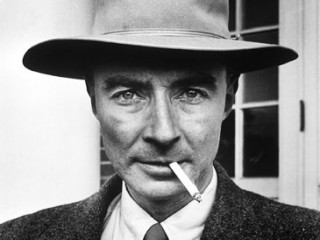
J. Robert Oppenheimer biography
Date of birth : 1904-04-22
Date of death : 1967-02-18
Birthplace : New York City, New York, U.S.
Nationality : American
Category : Science and Technology
Last modified : 2011-07-07
Credited as : Theoretical physicist, developed the first nuclear weapons, Presidential Medal of Merit
On April 22, 1904, J. Robert Oppenheimer, whose father was a German immigrant and wealthy textile importer, was born in New York City. After attending the Ethical Culture School in New York, where his lifelong devotion to literature, the arts, and science was nurtured, he entered Harvard University in 1922 and completed his bachelor's degree in 3 years. He required only 2 additional years of study at Cambridge University and the University of Gottingen to complete his doctoral degree in 1927.
Following 2 years of postdoctoral study at home and abroad on fellowships, Oppenheimer became associate professor of physics at the California Institute of Technology in Pasadena. Almost immediately, however, he began spending part of each academic year at the University of California at Berkeley, and he simultaneously rose through the academic ranks at both institutions. His teaching and research abilities were so exceptional and his personal magnetism was so great that many of his students followed him in his annual Berkeley-Pasadena pilgrimages, often willingly repeating the courses he offered. In general, by attracting and training an unusually large number of highly competent physicists, Oppenheimer, more than any other individual, was responsible for moving theoretical physics in America from a position of obscurity into one of preeminence in the world.
Oppenheimer's own researches between 1926 and 1942 took root in his extremely insightful exploitation of the recently discovered quantum mechanics of Werner Heisenberg, Erwin Schrodinger, Paul Dirac, Max Born, and others. With Born he developed a now-standard quantum theoretical understanding of molecules and their spectra. He undertook extensive investigations on processes involving transitions to the continuous spectrum, showing, for example, how to understand the photoelectric effect quantum-mechanically. He explored electron capture and exchange processes, as well as electron-atom collision processes. In 1930 he presented a cogent symmetry argument that was later recognized to be tantamount to the prediction of the positive electron, or positron. He studied the production of cosmic-ray showers. He explored various problems in quantum electrodynamics, as well as the properties and role of the meson in nuclear forces. He helped develop the so-called Oppenheimer-Phillips interpretation of deuteronnuclear reactions, which eventually led to great insight into the structure of the nucleus. In all of these theoretical investigations—and many more could be cited— Oppenheimer displayed his genius in implementing Wolfgang Pauli's conviction that a physicist should concern himself first and foremost with those problems on the very frontiers of current knowledge.
To the general public, Oppenheimer, as a scientist, is best known for his role in directing the development of the atomic bomb at Los Alamos, the laboratory high on a New Mexican mesa at a site he chose. Many of America's foremost physicists were persuaded to come with their families to this isolated laboratory to beat the Germans in the development of the most awesome weapon of destruction in human history. When all of the huge and unique problems were solved, and the test bomb was exploded on July 16, 1945, in the desert near Alamogordo, N. Mex., Oppenheimer was deeply shaken. He thought of the words from the Bhagavad-Gita: "If the radiance of a thousands suns/ Were to burst into the sky/That would be like/The splendor of the Mighty One…./Iam become Death, the shatterer of worlds." Not much later Hiroshima and Nagasaki were obliterated.
Oppenheimer was a complex man, one who could inspire distrust as well as utter devotion, and one who could commit indiscretions as well as be a scientist of faultless integrity. After the war, his early left-wing sympathies, inflated by Senator Joseph McCarthy and his coterie of witch-hunters, made Oppenheimer the defendant in perhaps the most celebrated trial since the time of Galileo. In spite of the fact that Oppenheimer's past associations had aroused no undue concern earlier—he had received the coveted Presidential Medal of Merit in 1946 and had been serving on the highest policy-making committees—his security clearance was revoked, deeply shocking the vast majority of his fellow scientists. Not until 1961, when President John F. Kennedy made the decision to give the Fermi Award to Oppenheimer (it was actually presented in 1963 by President Lyndon B. Johnson), was a significant attempt made to publicly clear Oppenheimer's name. In the interim, Oppenheimer had been serving as the director of the Institute for Advanced Study in Princeton, giving his splendid administrative and technical talents to the young group of highly gifted physicists who had gathered there.
Oppenheimer will remain a subject of study, discussion, controversy, and admiration for years to come. His profound concern for uniting the intellectual community, and humanity in general, is evident from the vast number of lectures and articles he devoted to the subject. He died of cancer in Princeton on Feb. 18, 1967.
















